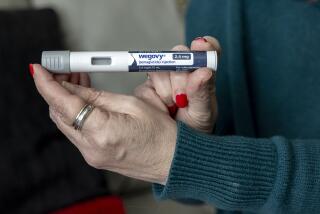Take one infusion, and call next year
Imagine going to the doctor’s office once a year for treatment of a chronic medical condition. No daily pills. No weekly therapies. Just 30 minutes or so in a clinic.
It could happen. A new osteoporosis drug called zoledronic acid has been shown to increase bone mineral density in rates similar to those achieved with medications taken daily or weekly. Now, a large study involving thousands of people will establish whether annual intravenous infusions can help prevent spine and hip fractures in people with osteoporosis.
If eventually approved by the Food and Drug Administration, zoledronic acid would be only one of several ways to treat bone loss. But doctors are exuberant at the prospect of having a long-lasting therapy in their bag of tricks.
“It will change the way we treat osteoporosis,” said Dr. Stuart Silverman, a clinical professor of medicine at UCLA and an investigator in the phase-three clinical trial. “Right now, osteoporosis is under-recognized, under-diagnosed and under-treated.”
About 55% of people over age 50 have low bone mass, and 10 million Americans have osteoporosis, according to the National Osteoporosis Foundation. The disease can lead to an increased risk of fractures and, sometimes, eventual death for elderly people who break a hip.
However, many elderly people with fractures are treated for the injury but don’t receive medications or therapy to prevent additional fractures, Silverman said. That might change if zoledronic acid infusions could be given as part of a comprehensive treatment for a fracture. About 20% of people with one fracture will have another break.
With zoledronic acid on hand, he said: “We would fix [the fracture] and then give them their osteoporosis treatment before they leave the hospital. We’d know they were protected for the next year.”
A once-a-year treatment would also benefit people who can’t tolerate daily osteoporosis medications such as Fosamax and Actonel. Like zoledronic acid, these drugs are from a class of compounds called bisphosphonates. And though they’re powerful protectors of bone, they’re hard on the stomach, says Silverman.
Furthermore, many people have trouble sticking to a daily-pill regimen; studies have shown that the average person stops taking long-term medications after six months, he said.
Zoledronic acid infusions appear to be well-tolerated. The major side effects are low-grade fever, musculoskeletal pain or nausea following the infusion. Zoledronic acid, made by Novartis Pharmaceuticals Corp., is not a new drug. It’s already being used, under the name Zometa, to treat complications of cancer that has spread to the bone.
“Bisphosphonates are a class of compounds that are soaps,” said Silverman, medical director of the Osteoporosis Medical Center, a nonprofit research center in Los Angeles. “They bind directly to the bone. They create a slippery surface and make it very difficult for the cells that remove bone to attach.”
Researchers don’t yet understand how a single, yearly dose of bisphosphonates can protect bone as well as a daily therapy. But a greater understanding of the drug is expected to emerge during the three-year study launched last month.
The study will test zoledronic acid in several groups: post-menopausal women with osteoporosis, people with recent hip fractures and people with Paget’s disease, the most serious degenerative bone disorder. Researchers will enroll 11,000 patients in 400 centers around the world in one of the largest drug-evaluation programs undertaken in the area of metabolic bone diseases. More information on enrollment is available at www.horizon.novartis.com or by calling (877) YHORIZON.
If the medication proves successful at preventing fractures, it would probably be used in conjunction with other osteoporosis treatments, such as the newly approved medication Forteo, which can help build new bone.
“There are a lot of exciting things happening with osteoporosis,” said Silverman.
“It’s not a disorder of aging. It’s treatable.”
*
(BEGIN TEXT OF INFOBOX)
Out with old bone, in with the new
Bones are not the solid, fixed structures we often assume them to be. They’re actually in a state of flux known as the remodeling cycle. This cycle has two parts:
Bone resorption: Special cells called osteoclasts dissolve old bone by removing calcium and other minerals from the bone and depositing them back in the bloodstream.
Bone formation: Cells called osteoblasts create new bone by removing calcium and other minerals from the blood and depositing them in the cavities where bone is needed.
Bone diseases like osteoporosis, which means “porous bones,” develop when old bone is lost faster than regrowth can occur. Small holes develop that can eventually weaken the bone so much that a fracture or break occurs.





